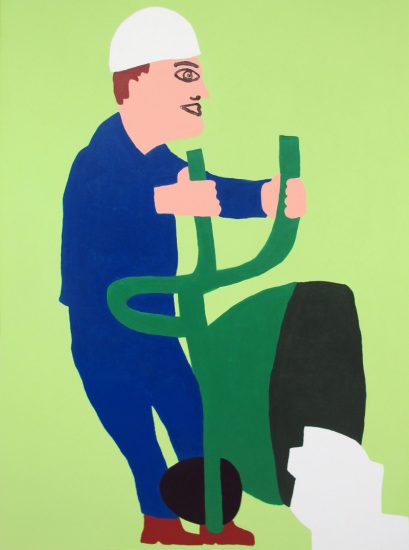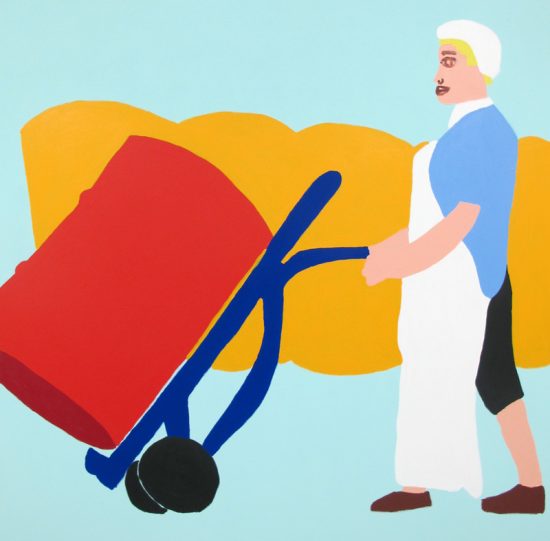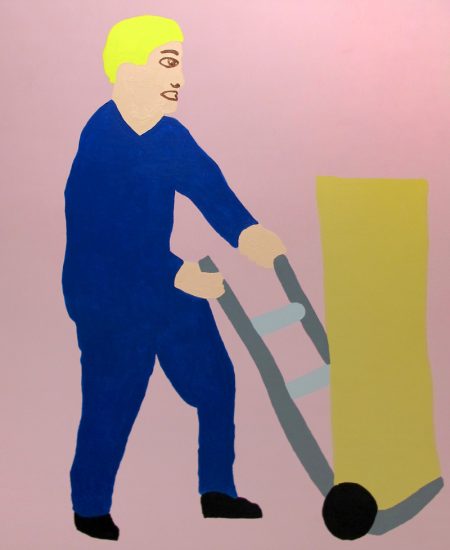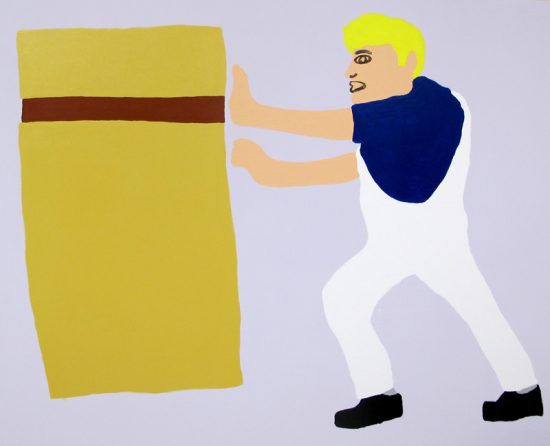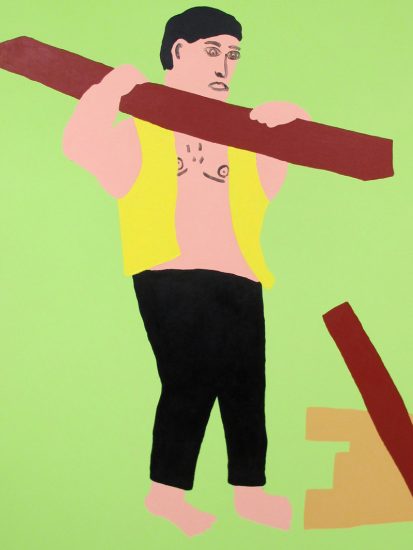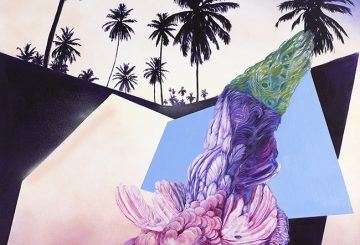Andrew Frost: The first question I have to ask you is about your old work. The first time I became aware of your painting was when I saw one of me that you’d done for a show, a picture I thought must have been based on something from TV! It seemed to me that you were influenced by Adam Cullen at that stage, or you were quoting him. Can you tell me about that work and the evolution to the kind of thing you’re doing now? What are the connective points?
Nigel Sense: I love Adam Cullen’s work and I guess when you are starting out you emulate your hero’s until you find your own voice. I always liked that about David Bowie, he was a bower bird taking things from everyone but then turning into his own. But to be honest the thick black outline I was using at the time was a bit of a safe guard. It would always fix any mistakes in the painting. As the black line went down last, it would hide all the imperfections. As I got more confident as a painter I realised I wanted to celebrate the mistakes and not hide them. The quote on the painting wasn’t from Cullen, but from what an artist once told me about you when I was first starting out. “Don’t show Andrew Frost your work” he said, “he might think your paintings are shit”. I thought that was an odd way of thinking as you’ve got be open to feedback and criticism, and to be honest I really wanted you to see the work no matter what you thought. My work back then used a lot of iconography, whether that was brands or people, but whatever the subject it was related to bogan Australia & exploring the Australian cultural landscape, often in a slapstick or piss-taking way. This is still the main subject of my work but I guess I see at it in a more mature way. I don’t take the piss as literally as I used to, but there’s still humour in it. Also, brands come and go, but stereotypes and personalities are the same, so I stopped doing brand icons and focused on people as icons.
Nigel Sense, Davo, 2017. Acrylic on canvas, 110x155cms.
Nigel Sense, I Used To Be In A Band, 2017. Acrylic on canvas, 122×122 cms.
AF: Your work now has the look of what some people call ‘deskilled’ painting, but that kind of style can be very deceptive. What for you are the key elements of your new work?
NS: Deskilled! I like that word. Yes – making good mistakes is very hard to do. Just because things are done badly doesn’t mean its bad, and I love this. Tom Waits or Bob Dylan are pretty shitty singers and The Ramones can’t really play their instruments, but that’s why they are great. That’s the element I want more and more in my work. An unapologetic practice that embraces my flaws, my strengths and my bad time management. I am just going to paint what I see. An Artist told me once “stop whinging about working a morning job and make it your art practice”, so I’ve embraced this sentiment.
AF: What’s your view on the use of colour in these pictures?
NS: I plan it, but I don’t over think it in any sort of conceptual way. But if you do look at cultural stereotypes, like a blue collar worker, they mainly all wear the same uniform. I’m naturally drawn to using bright, bold and clashing colours. Whenever I try to tone this back or refine it or make it closer to reality it doesn’t work for me. Another reason for my use of colours might be because I’ve got really bad eyesight, it’s so bad that legally I’m not allowed to drive. So I guess this is how I see the world – more in blocks of colour rather than in detail. And for the details I can’t see, I’ll just invent something.
Nigel Sense, Johnno, 2017. Acrylic on canvas, 110x155cms.
Nigel Sense, Daz, 2017. Acrylic on canvas, 110x155cms.
AF: How do you put your pictures together? What’s the process?
NS: I have a morning job which has been the subject for my paintings for quite a while now but has also influenced and changed my painting process. All my painting ideas are drawn up at work so I have only a few minutes for a quick sketch at a time. The drawings are fast and nothing is corrected. It is what it is, it works or the drawing goes in the bin. As my job has changed and now I have more responsibilities at work, the drawing need to be done even more quickly making them very loose, which I think is great. I find if I tried to draw as quickly and loosely at my studio, without the time restrictions it doesn’t work as well. At work I need to keep one eye out when I’m drawing because if I get caught I’m going to get in trouble. Half the time I’m not paying attention on what I am drawing. Every day I come home with my pockets full of drawings which get thrown onto the studio floor. Once I’m in the studio its very primal. Turn the music on pick a drawing off the floor and paint it as quickly as I can. I usually paint a few at once so I don’t need to stop and wait for the paint to dry.
Nigel Sense, Wazza, 2017. Acrylic on canvas, 110x155cms.
AF: Tell me about the subject of these pictures – it’s thematically about the world of blokes and work. Is there a critique or celebration?
NS: A critique or celebration, It’s both really. I grew up in Dapto and you know old the saying “You can take a man out of Dapto, but not the Dapto out of the man.” There’s something I dislike about suburbia, but on the same hand its so comfortingly familiar. I believe its something everyone can relate to, even people who’ve never step foot inside a gallery. As much as I left Dapto as soon as I could, my dad still lives there and I have a lot of respect for what he’s done in his life. He’s a hard days work for a good days pay kind of person. Even if they pay wasn’t that good he did it with a smile. So yeah, the more I explore this through my work, I see it is a celebration of that kind of sprit.
Nigel Sense, Workers and Wankers, Fox Galleries, Melbourne, until May 12, 2018.
